After the storm: THRIVE’s efforts in helping households in Jere recover from crises
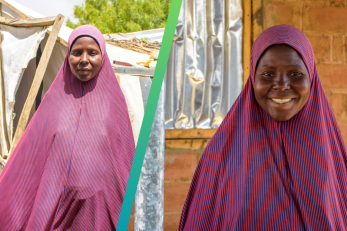
“Oh, what next, after the storm?” It is a line from the theme song of a popular Nigerian soap opera in the 1990s. At that time, Jere Local Government Area (LGA), Borno State, and most of northeast Nigeria had experienced years of stability and peace. The largely agrarian society thrived during this period; it was a time marked with economic growth and low crime rates, and Borno State was dubbed the liveliest state in the region with a steady influx of people from other regions of the country.
As families sang “what next after the storm" on their couches while watching their favorite show on Thursday evenings, there was no way they could have imagined the storm that would emerge some 10 years later - the Boko Haram insurgency. The crisis hit Borno State hard, rendering about half the population of the state—3.9 million people in need (PiN)—according to the U.N. OCHA Humanitarian Needs Overview, 2024. Also, the U.N. Development Program (UNDP) estimated in a 2021 report that a total of 350,000 deaths were caused directly and indirectly by the conflict. 13 years later, the prolonged crisis has led to the breakdown of commerce and societal structures, leaving Jere and northeast Nigeria in shambles. The storm has come and still lingers, but then, just like the song said, "What next?"
While the primary responsibility of rebuilding Jere and environs rests on the shoulders of the government, and residents of affected communities, the significant work that needs to be done will prove too difficult without support from the outside world. Stepping in to bridge this gap, the Transitioning Households to Recovery from Vulnerability (THRIVE) program, a consortium that includes the Catholic Relief Services (CRS), Mercy Corps, Women in New Nigeria (WiNN), Salient Humanitarian Organization (SHO), and Justice Development and Peace Commission (JDPC), and funded by USAID, brought life-saving support and complimented recovery efforts through their area-based approach in Jere LGA.
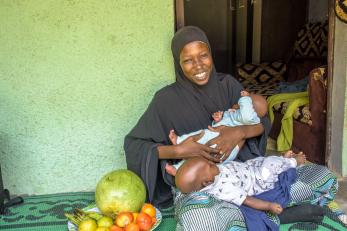
Amina Umar, a 27-year-old mother of three, welcomed a set of twins two months ago. “THRIVE’s food assistance and supplemental nutrition assistance played key roles in my safe delivery and the health of my babies,” she narrated. Having felt the pain of losing a child before, Amina was overjoyed while appreciating THRIVE.
“The previous pregnancy was tough,” she said. “After having the baby, she was often sick and died subsequently,” she continued. Amina shared how her husband earns very little and can afford only one class of food. “My husband only bought either rice or maize before the food assistance, but now I can choose what I want; having this variety has helped us a lot,” she enthused. “The twins are also able to get the nutrients from the fruits and vegetables from the breast milk I feed them,” she concluded.
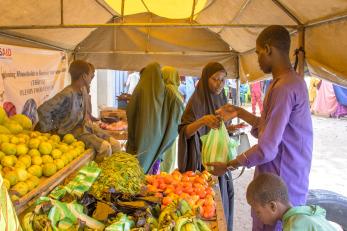
The THRIVE program has a graduation model that empowers participants to step towards greater food security. Depending on vulnerability, some participants graduate from direct food assistance to the agriculture component. Here, women learn sustainable gardening techniques and receive input for perma gardening and noiler chickens. This helps families gain consistent access to fresh vegetables and protein, complementing the nutrition efforts of the program.
Kellu Adam is one of such participants and has benefited from this initiative. “I collected food for four months, and when they told us we would be transitioned, I was really worried,” Kellu said. “But when I received the chicken and perma garden inputs, I was excited by the endless possibilities it represented,” she continued. Having raised all her birds, Kellu now enjoys the eggs they lay and sells some to a shop nearby. “The chicken and vegetables are not only sources of nutrients for my family, but they have unexpectedly also become a source of income because I sell the extra to shops around here at NGN40 per egg,” she narrated. Kellu uses the money she gets to buy feed for the chicken and can save NGN6,000 monthly. “When the chickens stop laying, I will sell them and buy more; this can be a means of livelihood for me.” She concluded.
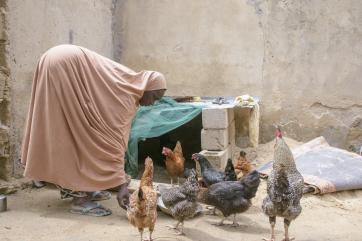
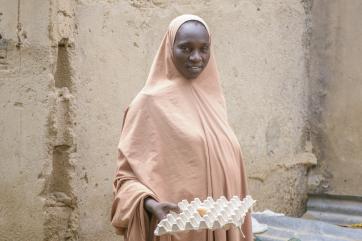
A key component of the THRIVE program is the construction of improved mudbrick shelters for participants. The shelter, the product of applied research by Mercy Corps and other partners, is designed to last much longer than local mudbrick shelters. Hamsatu Mohammed, a mother of 7 who benefited from this initiative, was overjoyed while sharing her story. “I cried when they built this house for me,” she said. “I had given up hope that I would ever live in a house that belonged to me. Everyone in the community is happy for me,” she continued. The family owned a small piece of land before the insurgency, but with the onset of the insurgency and the loss of livelihood opportunities, they could not develop the land until THRIVE came along. “We made a shelter out of local materials,” Hamsatu narrated.
The poor condition of the previous shelter meant that Hamsatu faced many challenges all year long; the roof leaks during the rainy season, and the family must stay awake when it rains at night. In her words, “snakes and other animals often enter during the hot season too because the house is not secure enough.” Also, while the family of 9 all slept in the same room prior to the construction of the mudbrick shelter, the new house enabled them to have separate rooms, thus decongesting their sleeping condition and reducing the risk of the spread of sickness and diseases.
The area-based approach of the program meant that Hamsatu benefited from more than just the shelter and settlement component of the program. She also enjoyed the food assistance and water, sanitation, and hygiene (WASH) components of THRIVE. A borehole was rehabilitated right in front of her new house. In her words, “the borehole that was there initially was vandalized, and we have lacked water ever since. We had to fetch water from the river close by.” The water body that flowed from the Alau Dam is unfit for consumption as children play and sometimes defecate in it.” “On several occasions, we see worms in the water, and my children are frequently ill. Whenever I take them to the hospital, they tell me to give them clean water to drink,” she narrated.
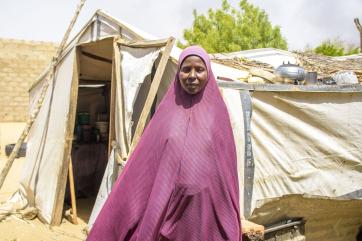
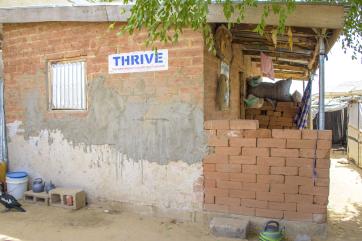
The WASH component of THRIVE also constructs latrines for vulnerable households. An initiative Fatima Babagana, a mother of eight, greatly appreciated. “We did not have a toilet and had to go to our neighbors whenever we felt like defecating,” she said. “The most stressful part of it is having to wake up several times in the night to take the children where they can urinate, seeing that the place is far and they cannot go on their own,” she continued.
Like Hamsatu, Fatima benefited from several components of the THRIVE program. She had her home repaired, collected food and agricultural inputs, had a borehole rehabilitated close to her home, and participated in the early recovery and market systems (ERMS) component. The ERMS component provides training and resources to support local business development. Through this, Fatima received tailoring training and a sewing machine as a startup kit. “Out of all I received, this toilet and home repair is my favorite. I now have a place where I can receive guests and a toilet they can comfortably use. This gladdens my heart even more than the food assistance,” she exclaimed.
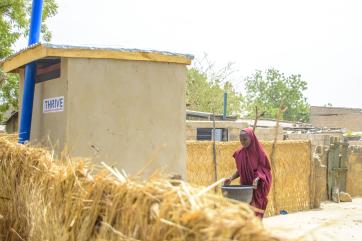
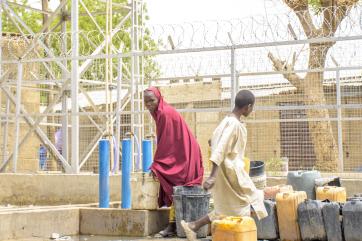
While the ERMS component of THRIVE might not be Hamsatu’s favorite, it certainly is for Mohammed Mustapha and Bashir Bukar. Mohammed was just 8 when the insurgency started and has vague memories of the glory days of Jere. “I can remember a time we had to run away and spend days in the bush when they attacked my community,” he narrated. “I still am able to remember this because I suffered a lot that time,” he continued. For many youths like Mohammed and Bashir, the present realities of Jere are all they know. A reality where children are out of school, and where adults and youths have no meaningful source of livelihood. “I stay at home all day, and whenever I need money, I ask my mother,” Bashir shared.
At the top of the THRIVE graduation ladder is the early recovery component, where youths from homes benefiting from the intervention are allowed to choose a livelihood skill and receive training in it. Mohammed and Bashir chose tailoring and have teamed up to set up a joint business since graduation. “When we received the startup kits, we both were working from home and made roughly NGN1000 daily. We then discussed and saw an opportunity to earn more by renting a shop together, and we did. Now we earn up to NGN4000 daily.” Mohammed exclaimed. The duo had to take out a loan of NGN40,000 from their parents to set up their workshop and have since been saving up to pay it back.
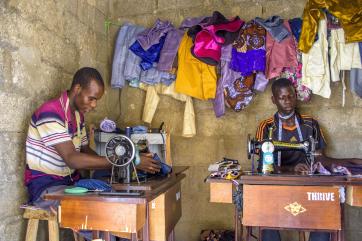

It was not all easy sailing for the duo, though, as Bashir had to risk family ties for his business to thrive. “When I brought the sewing machine home, my parents asked me to give it to my sister so she could take it to her husband’s house, but I sternly refused. I told them I wanted to use it and create a future for myself,” Bashir narrated. Every risk of this straining the relationship between him and his sister has been mitigated since he sewed her children’s upcoming Salah clothes for free. “The day I gave my mother money for the first time was the proudest day of my life,” Bashir exclaimed.
After 24 months of implementation, the THRIVE program has distributed food to 5,219 households, reaching 39,342 individuals. Also, 2,988 pregnant and lactating women received supplemental nutrition assistance through fresh and fleshy food redemption; 2305 women received inputs for perma garden; 1,703 received 10 noiler chickens; and 189 were supported with seeds for rainfed arable crop production. Additionally, 100 mudbrick shelters and 72 moveable shelters were constructed for participants. 430 latrines were constructed for households, 476 latrines were rehabilitated, and 21 boreholes were rehabilitated. The ERMS component trained 664 youths with livelihood skills while setting up and supporting 100 savings groups. All these were carried out while the protection team established 40 safe spaces with 1,016 participants. The stories emerging from Jere are evidence of the fact that, when given the right support, communities can emerge stronger and better after every storm and be better positioned to weather future storms.
About THRIVE
Transitioning Households to Recovery from Vulnerability (THRIVE) is a 2-year program funded by USAID to provide context-specific humanitarian assistance with the goal of initiating early recovery in Jere Local Government Area, Borno State.
THRIVE works in four wards: Mairi, Mashamari, Dusuman, and Maimusari in Jere Local Government Area (LGA), Borno State, to deliver a multi-sectoral, integrated, and coordinated response, informed by participants, that leverages experience and best practices to address the multi-faceted needs and 3/10 aspirations of vulnerable people. Its area-based approach advances participants from lifesaving assistance to life-building support.
THRIVE is implemented as a consortium by the Catholic Relief Services (CRS), Mercy Corps, Women in the New Nigeria (WINN), Salient Humanitarian Organization (SHO), and Justice Development Peace Committee (JDPC).